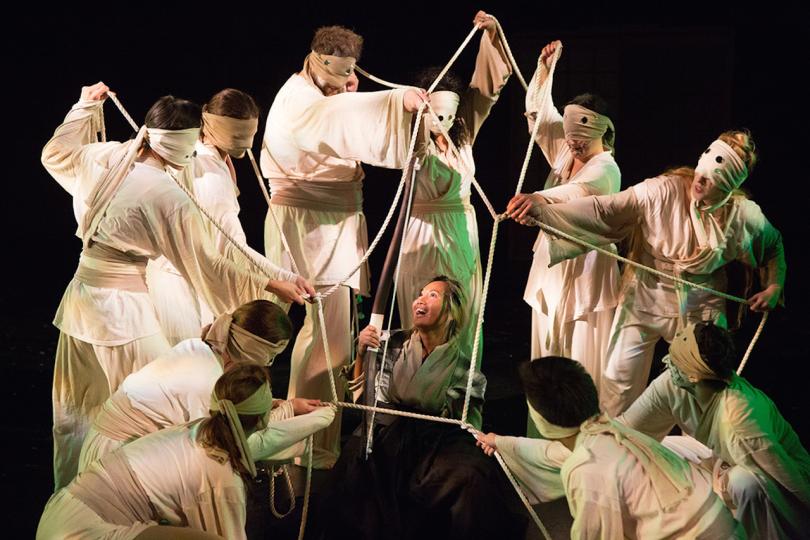Best of 2015-16: Twin Cities Horror Festival

Editor's Note: As the 2016-17 theater season begins, we like to reflect on the past year's season. To be inspired by the best.
I spend a lot of my time looking for movies I’m not supposed to see. I don’t necessarily mean movies that are notorious or flat-out awful, although those do come up in my rotation quite a lot. My favorite viewing fare is stuff that’s hard to find not because of controversial content, but because no one particularly cares enough to keep it in circulation.
I get a unique sense of fulfillment watching offbeat films that have faded into deep obscurity, movies like the middling Sterling Hayden lumber drama/musical Timberjack, or the loopy ‘60s Maltese Falcon knock-off The One-Eyed Soldiers. Watching these movies, I’m acutely aware of all of the artistry and energy that went into making them. Not to be too self-aggrandizing, but I feel as though I’m fulfilling a duty to the arts by making sure that at least one person remembers and appreciates those efforts decades later.
That’s all a long-winded way of saying that I appreciate theater that shows me something I’ve never seen before and is likely to go overlooked. Obviously, the stakes are different with theater than with film. However obscure a movie is, as long as there’s a surviving print of it, there’s a possibility of viewing it years, even decades, after the fact. Once a play has wrapped up its strutting and fretting, though, that particular incarnation ceases to be, which makes it feel all the more special when you manage to catch a glimpse of something small and strange.
Small, strange, daring and distinctive
As we all know, the Twin Cities theater scene offers an embarrassment of those small, strange riches. Even when a show doesn’t hit on all cylinders, I’m a sucker for something daring and distinctive that exists In Spite Of rather than Because Of. That can be something as niche as Stage of Fools mounting the Biblical courtroom drama The Last Days of Judas Iscariot in a fully appointed church sanctuary. It can be a peculiar blend of the personal and the popular like Mu Performing Arts’ tot: The Untold, Yet Spectacular Story of (a Filipino) Hulk Hogan. It can be a physically modest but thematically vast dive into pop culture like Workhaus Collective’s Lasso of Truth (co-produced with Walking Shadow). Or it can be a visually ingenious handling of a deeply familiar property like Children’s Theatre Company’s The Snowy Day.
For my money, though, there’s one mainstay of the Minnesota scene that packs more of the weird and wonderful into a week-and-a-half than most theater communities could hope for in an entire season. In its fourth incarnation, the Twin Cities Horror Festival cemented its place as arguably the most singular and exciting event in local theater. Housed in the inherently creepy confines of the Southern Theater, TCHF is somewhat of a fascinating contradiction, a festival focused on a specific, challenging genre that nonetheless offers something for just about everybody. There’s comedy. There’s dance. There are necrophiliac rock operas, Japanese folk tales, psychological thrillers and full-on gore extravaganzas. There’s even a dance party for adorable little kids in costumes.
The other festival
It would be easy to damn TCHF with the faint praise of being Fringe in microcosm, but that’s not wholly accurate. While the festivals certainly have some things in common - most obviously their embrace of eclecticism - TCHF’s narrower focus allows for a tighter, more consistent roster of shows. I’m a great fan of artists confining themselves to specific parameters. While some of the festival’s mainstays do make horror theater all year round, for many being constrained to 60-minute genre pieces is a challenge on top of a challenge. Exceptional artists don’t look at that as a restriction on their creativity, but rather a license to explore the boundaries of those limitations.
That leads to comedy-oriented creators like Four Humors, Dangerous Productions and Mike Fotis exploring their macabre sides, with results ranging from jet-black humor to smothering tension to all-out gore. It allows dancers and choreographers like Erin Sheppard and Green T Productions to dig into the underexplored terrain of scary movement. And it gives horror-theater lifers like Tim Uren an overdue spotlight for their craft.
For me, that’s a big part of what makes this event in general, and the 2015 edition in particular, such a special thing: while most of these shows probably could exist without the Horror Festival, I’m not sure how many of them would. For whatever reason, for some viewers the umbrella of an official festival legitimizes art that they might otherwise overlook. TCHF makes for a palatable invitation to some fans who generally avoid horror, and to others who generally avoid theater. It allows up-and-coming artists to share a bill with bigger-name companies who always draw a crowd.
And of course, it fosters any number of those hidden gems I mentioned earlier, shows that don’t rake in the Iveys or go on to long-run engagements, but ones that live on in the memories of their specific niche audience. TCHF does a great job of evangelizing its genre, but at its core it’s still a cult thing. And for those of us with cultish inclinations, that’s exactly as it should be.




